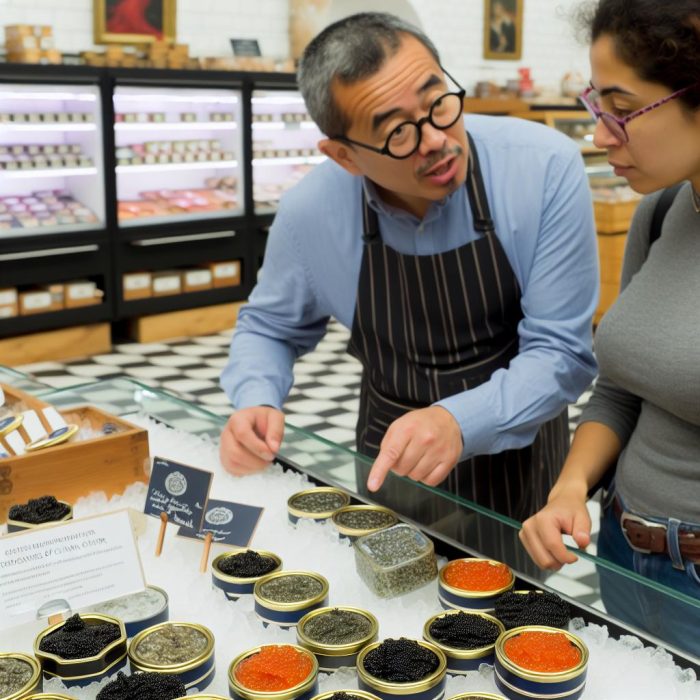Understanding Caviar Basics
Caviar, a luxurious delicacy, consists of salt-cured fish eggs from sturgeon. It has a rich history and an air of sophistication surrounding it. For those interested in acquiring this gourmet item, it’s essential to delve into the various types of caviar to make an informed purchase. The most renowned types include Beluga, Osetra, and Sevruga. These types are distinguished by their unique flavors and textures, each offering a different experience to the consumer and significantly influencing preferences.
Types of Caviar
Beluga caviar is perhaps the most sought after, known for its large, pea-sized eggs. It features a delicate skin with a creamy taste on the palate. This type of caviar commands the highest prices and is often a symbol of ultimate luxury. The rarity of Beluga sturgeons and the exquisite quality of the roe contribute to its significance.
Osetra caviar, on the other hand, provides a more complex profile compared to Beluga. It boasts a nutty flavor with medium-sized grains, appealing to those who enjoy a subtle yet distinct taste. The color of Osetra caviar can vary considerably, ranging from golden to dark brown, adding to its allure and uniqueness.
Sevruga caviar is appreciated for its smaller grains and robust flavor. The eggs are generally darker and are saltier compared to the other types. Despite being less expensive, Sevruga offers a strong and bold taste, setting it apart as a preferred choice for many connoisseurs. Each type of caviar is associated with specific regions and sturgeon species, which undoubtedly impact their quality and pricing.
Sourcing and Sustainability
A critical aspect to consider when purchasing caviar is its source. Sustainable practices are imperative for ensuring that sturgeon populations remain healthy, given that many of these species are endangered. Ethical sourcing involves employing aquaculture methods that don’t harm wild populations.
Many caviar brands today focus on sustainable practices. By choosing products that adhere to these principles, consumers can help preserve this precious resource. The Caviar Standard is an excellent resource for identifying brands that adhere to sustainable and ethical practices, guiding consumers towards making responsible choices.
Reading Labels
An often-overlooked aspect of buying caviar is understanding the information presented on the labeling of a tin. The label contains crucial details such as the species name, indicating the type of sturgeon from which the eggs were harvested. It also includes the grade of the caviar, which provides insight into its quality. This grading is typically based on characteristics like size, flavor, and color of the eggs.
Equally important is ensuring the packaging is tightly sealed to prevent spoilage, and the product is stored in a cool, refrigerated environment. This guarantees the caviar’s freshness, an essential factor for maintaining the quality and enjoying the delicate flavors at their best.
Tasting and Quality Assessment
Long before purchase, having the ability to assess caviar quality proves beneficial. High-quality caviar will have firm, intact grains with a shiny appearance. These characteristics are visual indicators of freshness and proper curing processes.
When tasting caviar, focus on its texture and aroma. High-grade caviar will emit a clean, fresh scent, devoid of any overly fishy odors. The eggs should roll easily in the mouth and burst with rich flavors, demonstrating proper maturity and preparation methods.
Pairing Caviar
To truly appreciate caviar, understanding the complementary pairings can enhance the experience exponentially. Caviar is most enjoyable when served chilled and typically presented on blinis or toast points. The addition of crème fraîche balances the saltiness and enhances the overall flavor profile.
Pairings that include beverages such as champagne or chilled vodka are traditional accompaniments, serving to cleanse the palate and highlight the caviar’s nuances. These pairings are not only classic but are designed to allow every note and texture to be savored fully, elevating the tasting experience.
Storage and Handling
Proper storage and handling play a pivotal role in maintaining caviar’s quality. It should be stored at the coldest part of a refrigerator, ideally between -2°C and 2°C (28°F and 36°F). This ensures the caviar retains its fresh and flavorful characteristics.
Once a tin of caviar is opened, it’s optimal to consume the contents within a few days. This timeline helps preserve the original taste and texture. When serving, using a non-metallic spoon is recommended to avoid any interference with the caviar’s natural flavors, as metallic spoons can impart an undesired taste to the delicate eggs.
Buying Caviar Online
With the advent of e-commerce, purchasing caviar online offers convenience and access to a broader range of options. Buying directly from suppliers can be advantageous, often ensuring authenticity and quality. However, it’s imperative to choose reputable vendors with positive customer reviews and transparent return policies. Trusted sources like Petrossian and The Stocking Hall are known for their commitment to quality.
Conclusion
Acquiring caviar with the discernment of a connoisseur involves several considerations—from understanding the different types available and sourcing sustainably to accurately reading labels and mastering tasting practices. By focusing on these factors, one can enjoy caviar with confidence, appreciating its luxurious qualities fully.
The quality and source of caviar significantly influence the entirety of the experience. As with any gourmet food, knowledge and careful selection contribute to the enjoyment and preservation of this exceptional delicacy. Through informed choices, caviar enthusiasts can ensure that this celebratory food remains a cherished part of culinary tradition.

